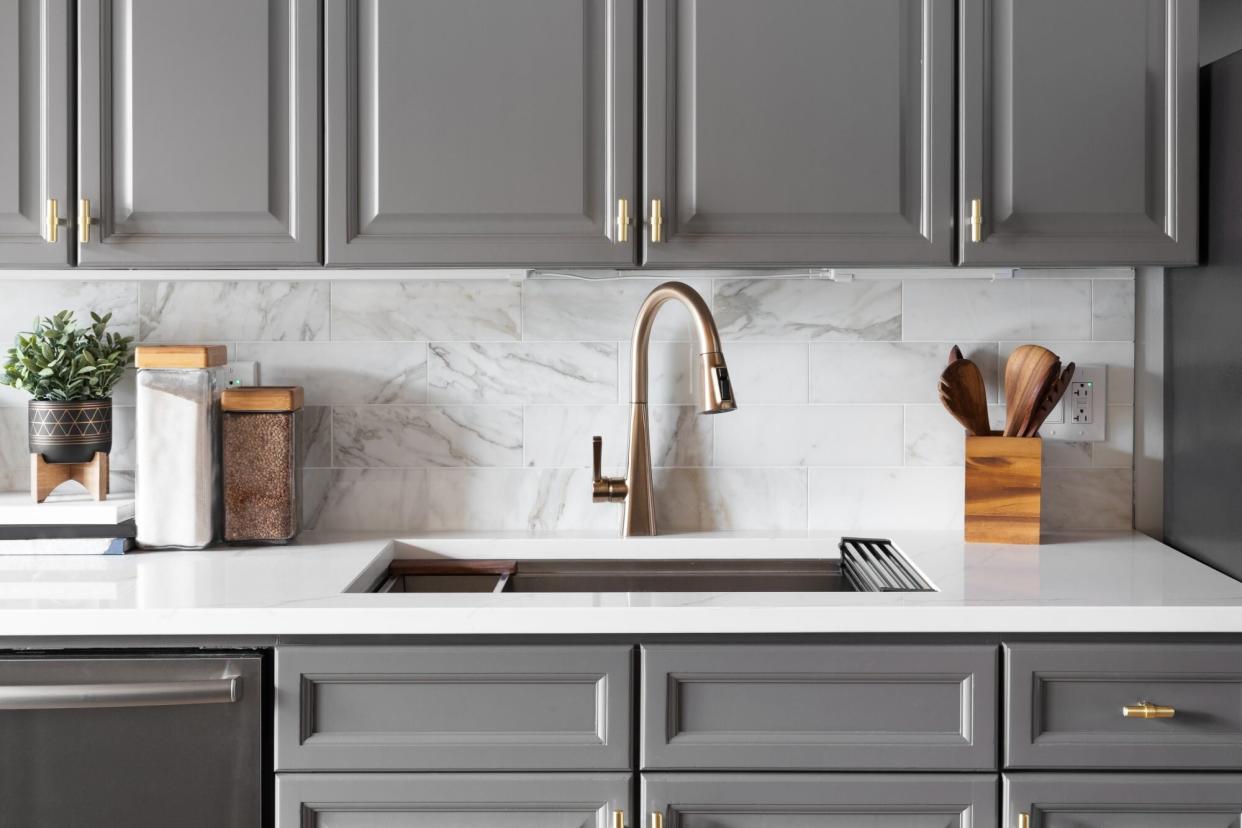How to Clean a Faucet Head—and Your Sink's Handles, Too

Joe Hendrickson / GETTY IMAGES
TABLE OF CONTENTS
On This Page
Faucet Cleaning 101
How to Clean a Faucet Head
Removing Stubborn Water Stains and Mineral Deposits
How to Clean Faucet Handles
You know that it's important to give your kitchen and bathroom sinks a thorough clean regularly, but the job extends beyond the basin. You need to give the same level of care to the faucet head and handles, too. Like the other parts of your sink, these pieces accumulate bacteria, stains, and smudges—and the faucet head in particular is susceptible to hard water deposits and mineral buildup, which could impact your water flow.
To ensure these parts look and work their best, make sprucing them up a key part of your bathroom cleaning routine. Read on to learn how to clean your faucet head and handles (the right way, of course!), according to our experts.
Related: How to Deep Clean Your Kitchen Sink
Why It's Important to Clean Your Faucets
Since faucets are our primary source for water, it's necessary to clean them every few months to prevent a buildup of dirt, debris, and hard water deposits, says Jennifer Parnell, co-founder of Humble Suds, a line of non-toxic, plant-based cleaning products. "Over time, mineral deposits from calcium and magnesium, as well as dirt, can build up," she says. "Not only do these minerals cause hard water deposits and stains, but they also slow your water flow."
How to Clean a Faucet Head
In order to clean a faucet head, you'll want to round up a few common household ingredients, says Leanne Stapf, COO of The Cleaning Authority. "My go-to when cleaning faucets is baking soda—it's great for freshening your stainless-steel appliances and items," she says. "Make sure to rinse it well so you don't leave behind any dirt or streaks."
Another essential is vinegar, as it removes hard water deposits and mineral buildup, says Parnell—but mind your faucet's finish. "If your fixture can withstand the acidity of vinegar, it is the best option for cleaning your faucet head," she says. "For example, vinegar can damage chrome finishes by eating the finish right off if left on the surface for too long." Vinegar should not be left on chrome for more than two hours, and this ingredient should not be left on nickel, gold, or brass for over 30 minutes, Parnell explains.
Materials You'll Need
Vinegar
Quart plastic bag
Rubber band
Toothbrush
Baking soda
Follow these expert-approved steps to clean your faucet head:
Fill a plastic bag with half water and half vinegar, ensuring there is enough liquid to submerge the faucet head.
Put the liquid-filled bag over the faucet head and secure it with a rubber band.
Let stand for 30 minutes to one hour. For more sensitive fixture finishes, do not surpass 30 minutes. You can also add a few tablespoons of baking soda for extra cleaning power.
After removing the bag, run hot water and scrub any loose debris away with the toothbrush.
Wipe down the fixture with soap and water or a mild neutral pH cleaner, like Humble Suds All Purpose Cleaner. You can also scrub around the crevices with a toothbrush to ensure they are thoroughly cleaned.
How to Remove Hard Water Stains and Deposits
If you're having trouble removing stubborn hard water stains and clogging deposits—and your water flow has been impacted—consider using powdered citric acid. However, proceed with caution: Some faucets will not be able to withstand this ingredient, and it can cause eye irritation, says Parnell.
Materials You'll Need
Powdered citric acid
Towel
Pliers
Toothbrush
Vinegar
Here are the steps to remove hard water stains from faucets:
Dissolve about 3/4 cup of citric acid in about 1 gallon of boiling water and fill a plastic bag with the mixture.
Secure the plastic bag over the faucet with a rubber band.
If you are unable to place a bag over your faucet, you can spray this cleaning solution on hard water deposits. Let the mixture sit for 30 minutes, scrub as needed, and then wipe away with soap and water. Do not use near soft, porous surfaces, like marble, granite, and soapstone.
If water flow is still poor, remove the faucet aerator (the small screen at the end of the spout) and clean it, says Parnell. Attempt to carefully unscrew the aerator. If it's stuck, use pliers—but place a towel around the aerator so you don't scratch the surface and twist carefully.
Soak the aerator in vinegar for 30 minutes and use a toothbrush to scrub away buildup.
Rinse under water and reattach to the faucet.
How to Clean Faucet Handles
Don't forget to clean your faucet's handles, too. Regularly cleaning the faucet's exterior and handles keeps hard water deposits, mildew and mold, and germs at bay. "This should be part of your weekly cleaning routine," says Parnell.
Materials You'll Need
A mild pH-neutral cleaner
Microfiber towel
Toothbrush
Here are Parnell's best tips to clean faucet handles:
Spray the fixtures and let sit for a few minutes with a mild pH-neutral cleaner.
Scrub the perimeters of fixtures with the toothbrush.
Wipe and polish the fixture handles with the microfiber towel.
For tough water stains, spray with a mixture between 2 to 3 tablespoons of citric acid and water.

